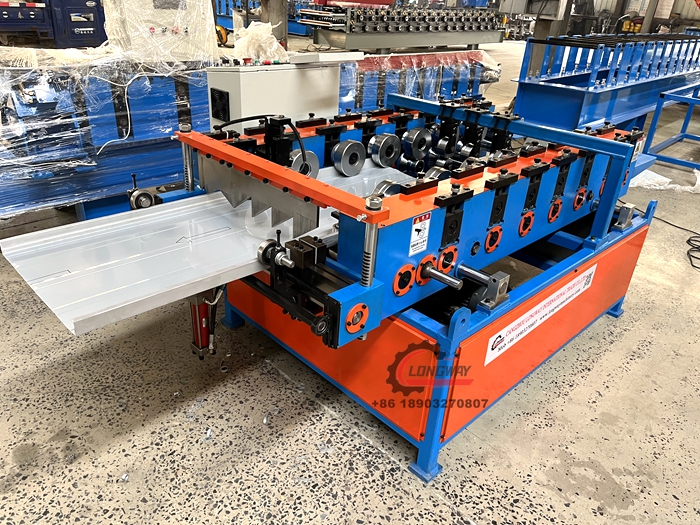roof roll forming machine
The Role of Roof Roll Forming Machines in Modern Construction
In the modern construction industry, efficiency and precision are paramount, especially when it comes to producing roofing materials. Among the pivotal tools that have revolutionized this sector is the roof roll forming machine. This advanced piece of machinery not only enhances productivity but also ensures that the quality of roofing components meets the highest standards.
What is a Roof Roll Forming Machine?
A roof roll forming machine is specifically designed to continuously shape metal sheets into roofing panels and other construction components. The machine operates through a series of rollers that progressively bend and form the metal into the desired profile. This process transforms flat sheets of steel, aluminum, or other materials into pre-engineered roofing profiles that are ready for installation.
Advantages of Using Roof Roll Forming Machines
1. Efficiency and Speed One of the foremost advantages of using a roof roll forming machine is its ability to produce roofing materials quickly. Traditional methods of roofing material production can be labor-intensive and time-consuming. In contrast, a roll forming machine automates the process, significantly reducing labor hours and material waste.
2. Customization Roof roll forming machines can produce a wide variety of profiles tailored to specific customer requirements. Whether it’s standing seam, corrugated, or tile-like roofs, manufacturers can adjust the machine settings to create unique designs that match architectural needs or aesthetic preferences.
3. Precision Engineering The technological sophistication of roll forming machines ensures that every panel produced adheres to strict quality specifications. With digital controls and automated processes, manufacturers can maintain tight tolerances and minimize defects, resulting in high-quality outputs that are consistent in dimensions and performance.
roof roll forming machine

4. Durability and Material Utilization Roof roll forming machines work with high-strength materials, such as galvanized steel or aluminum, which are known for their durability and longevity. The process minimizes waste since the machine can utilize sheets efficiently, reducing the amount of scrap material. This is not only cost-effective but also environmentally beneficial, reinforcing sustainability in construction practices.
5. Versatile Applications Beyond roofing, roll forming machines have applications in producing various metal components for construction, including gutters, downspouts, and even wall cladding. This versatility allows manufacturers to serve multiple markets and utilize the machinery for diverse product lines.
The Technology Behind Roof Roll Forming Machines
The technology in roof roll forming machines has advanced considerably over the years. Modern machines are equipped with features like programmable logic controllers (PLCs), which allow operators to set various parameters easily. Some machines are even integrated with computer-aided design (CAD) systems, enabling more complex designs to be created and produced with remarkable speed and accuracy.
These machines typically have several stations of rollers, each progressively shaping the material until the final form is achieved. The material is fed into the machine, and as it passes through each set of rollers, it is gradually bent into the desired profile. The process is usually completed with minimal manual intervention, which not only accelerates production but also reduces the likelihood of human error.
Conclusion
In conclusion, roof roll forming machines have become instrumental in modern construction practices. They combine efficiency, precision, and versatility, addressing the growing demand for high-quality roofing solutions in an increasingly competitive market. As technology continues to evolve, we can expect even more innovations in roll forming processes, further enhancing the capabilities of manufacturers and contributing to the development of sustainable building practices.
The future of the construction industry will likely be shaped by the advancements in machinery like the roof roll forming machine, highlighting the importance of embracing technology for efficient and sustainable building practices. The integration of these machines into construction workflows not only meets market demands but also propels the industry towards a more innovative and efficient future.
-
Roof Panel Machines: Buying Guide, Types, and PricingNewsJul.04, 2025
-
Purlin Machines: Types, Features, and Pricing GuideNewsJul.04, 2025
-
Metal Embossing Machines: Types, Applications, and Buying GuideNewsJul.04, 2025
-
Gutter Machines: Features, Types, and Cost BreakdownNewsJul.04, 2025
-
Cut to Length Line: Overview, Equipment, and Buying GuideNewsJul.04, 2025
-
Auto Stacker: Features, Applications, and Cost BreakdownNewsJul.04, 2025
-
Top Drywall Profile Machine Models for SaleNewsJun.05, 2025








